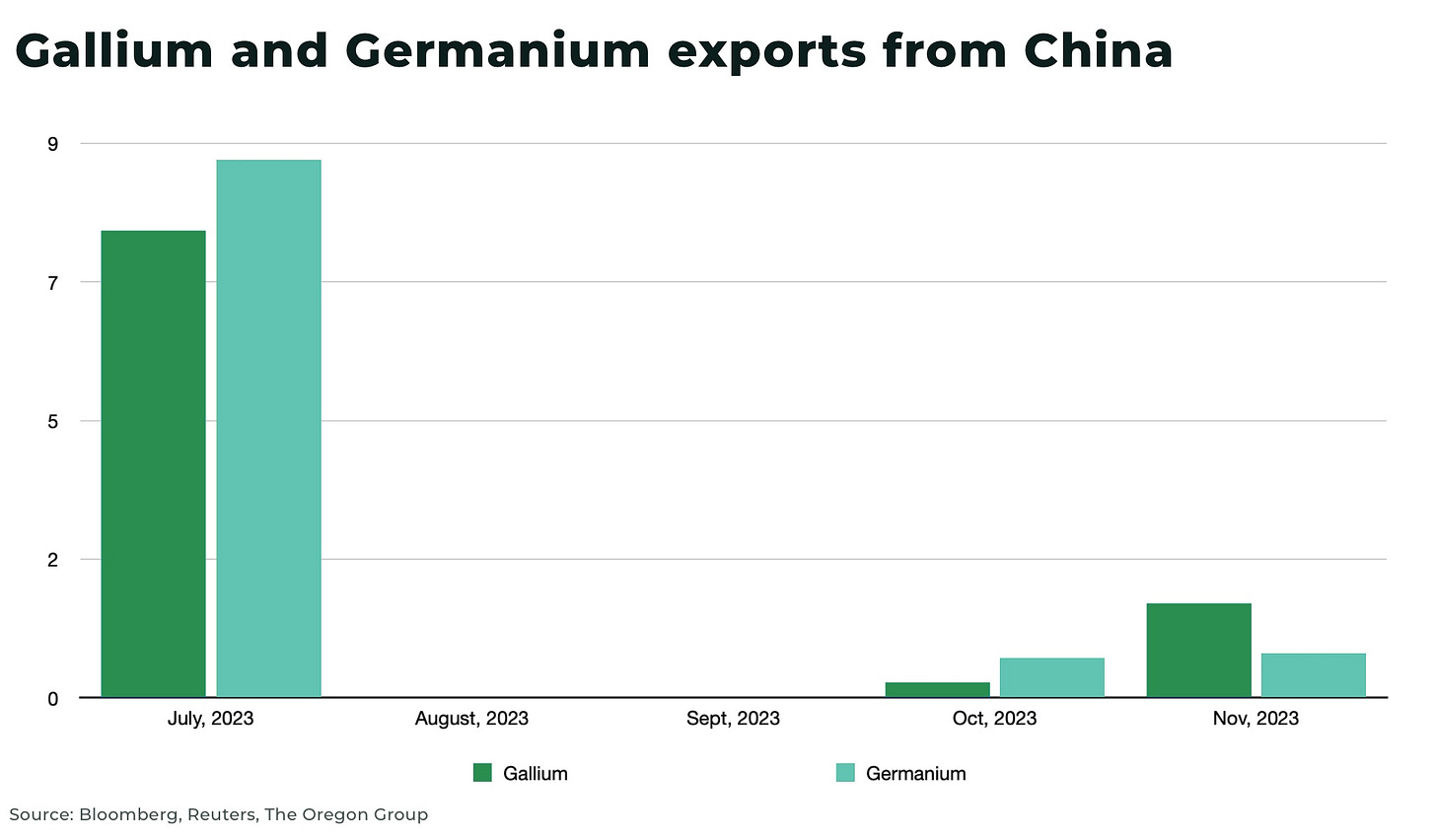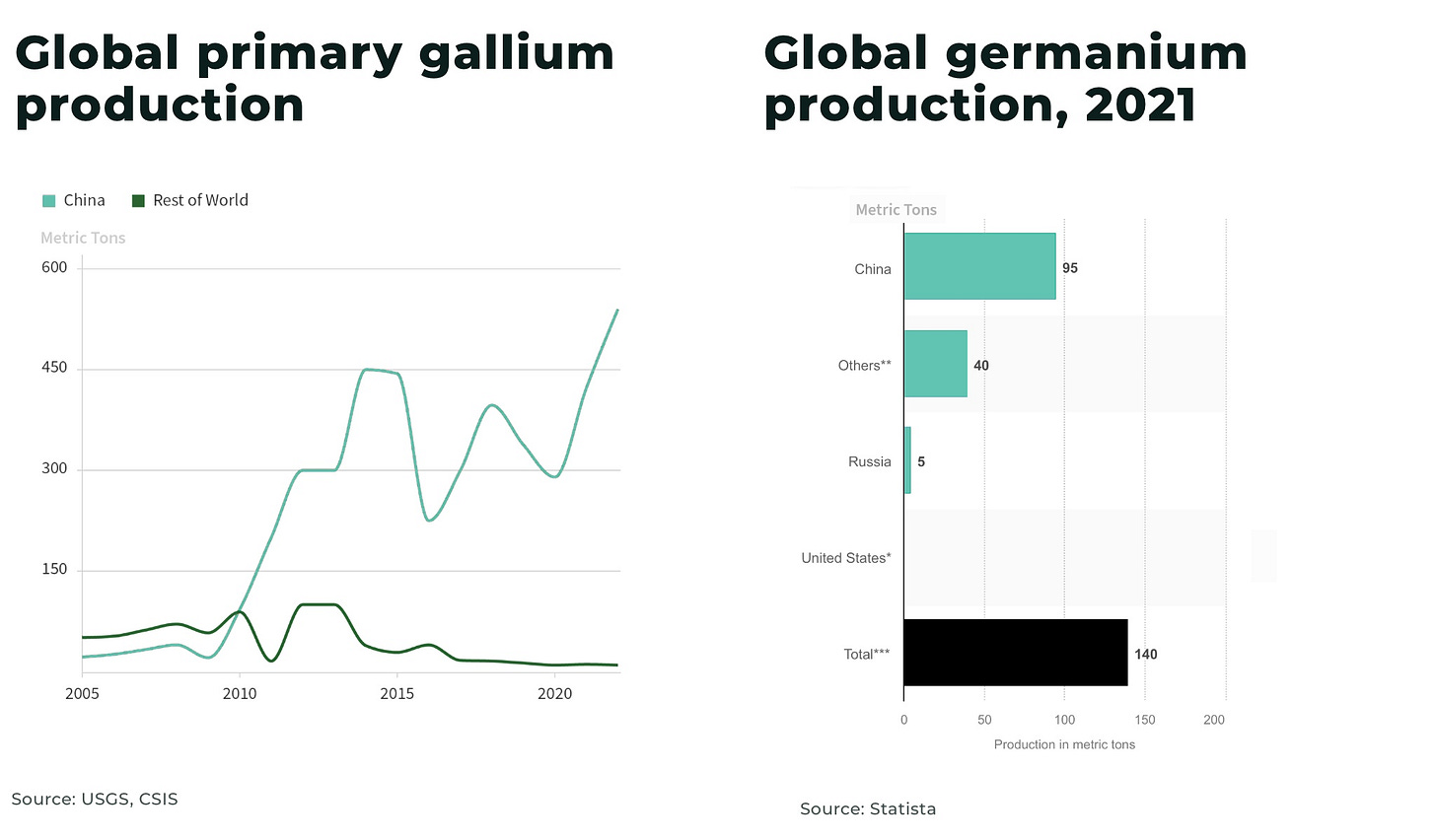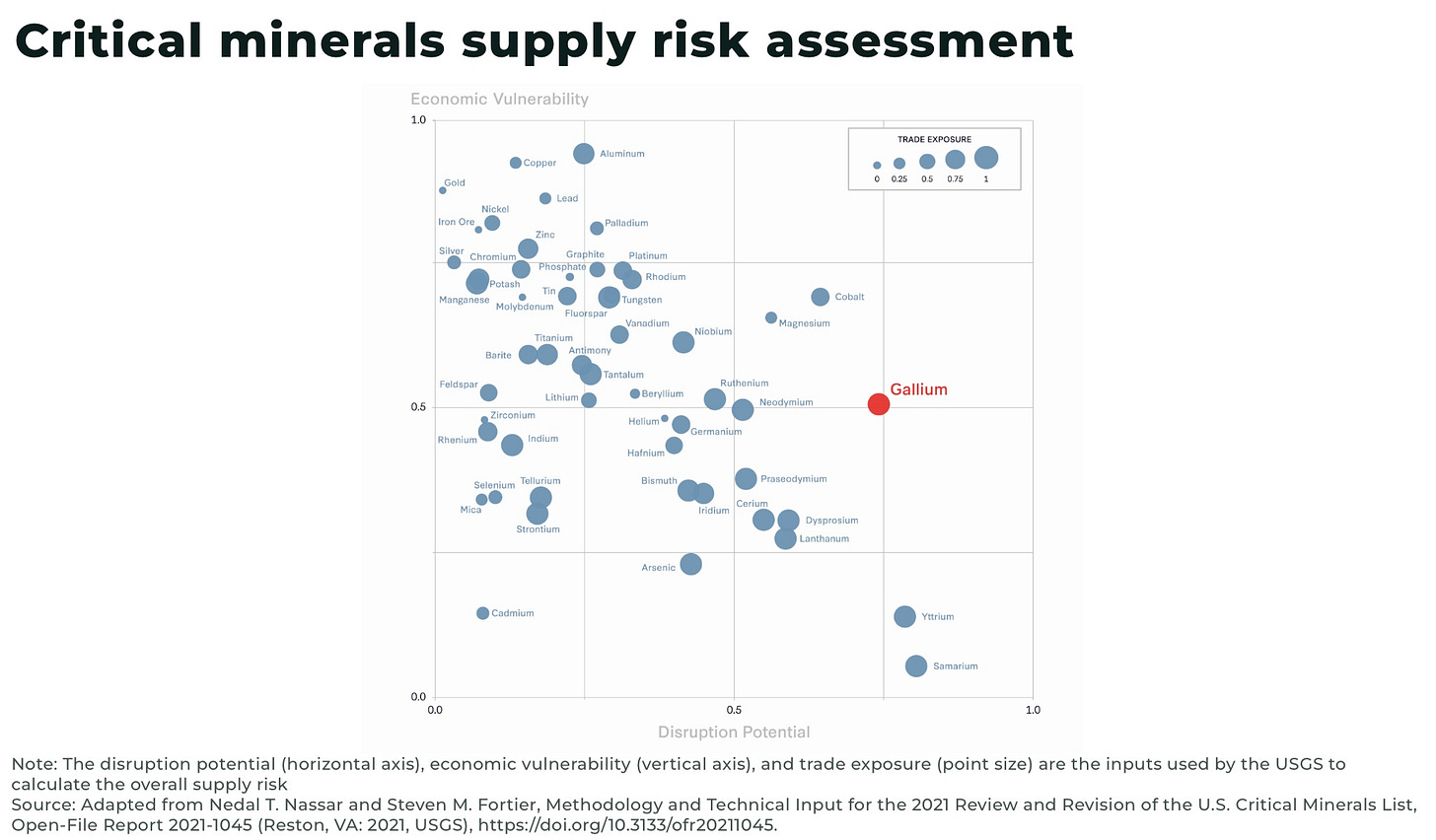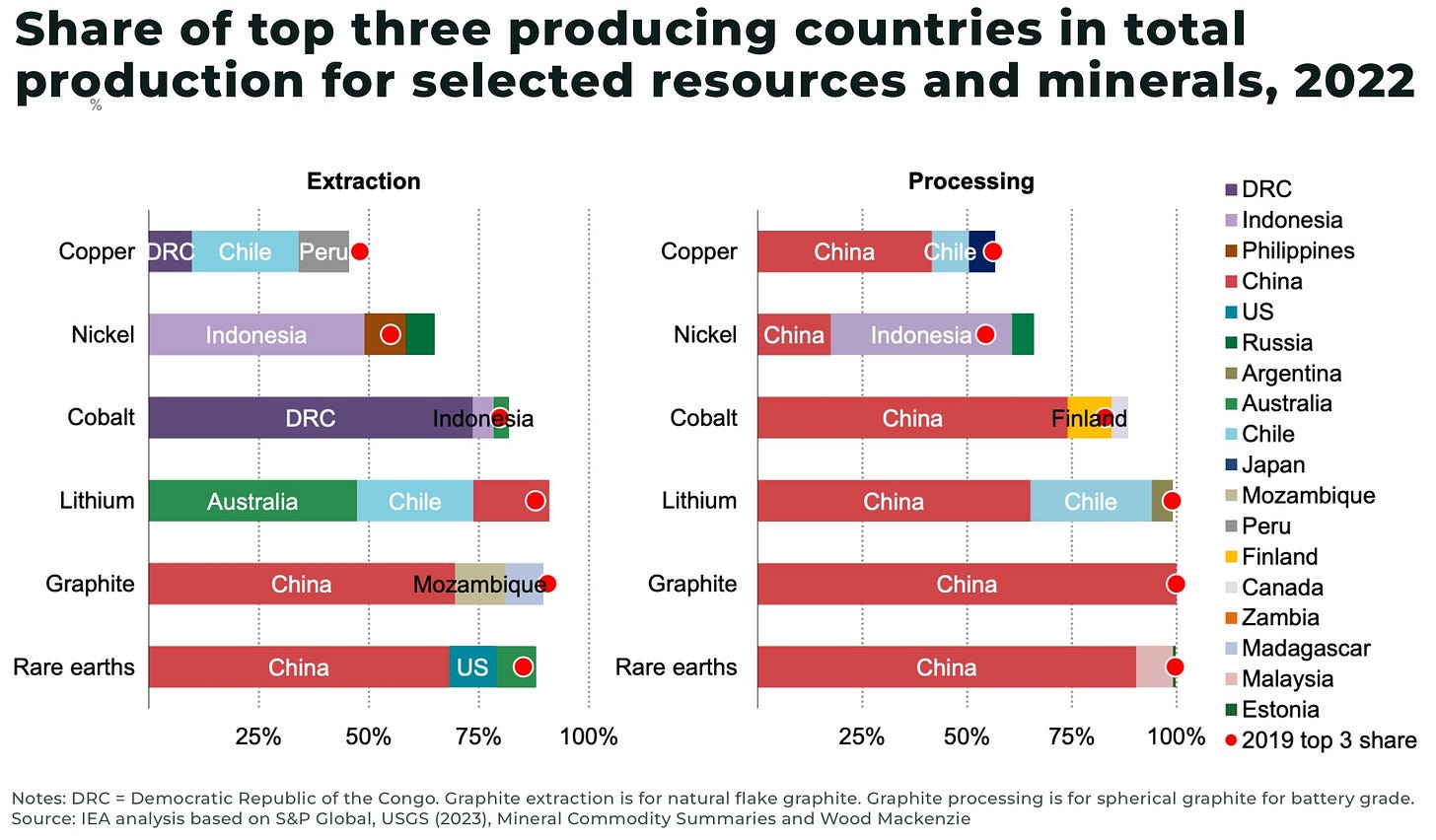The canary in the gallium and germanium mine
The "phoney" trade war may seem quiet, but China has cut exports of gallium and germanium by 80%, just as US-China trade war spills over into other critical minerals.
gallium and germanium are critical metals for semiconductors and military
exports from China, world’s largest exporter, fell over 80% after restrictions
the restrictions are the first in series of new critical mineral export controls
🚀 Please smash the ♡ button, subscribe for the banter ✓ and share with friends and colleagues. We are always grateful for your comments and support.
China’s restrictions on all exports of gallium and germanium — two metals crucial for semiconductors — came into force on August 1, 2023.
After no exports in August and September, Chinese authorities allowed only a “trickle” of exports in October and November; from 7.59 tons of gallium in July, to 1.53 tons in November, a drop of 80%.
For critical minerals and the West, gallium and germanium are the canary in the coal mine — a warning of danger — but what is the magnitude of the threat?
What are gallium and germanium
Gallium and germanium are both rare metals.
Gallium is produced when processing bauxite into aluminium, and some trace amounts can also be found in zinc; Germanium is mostly produced as a by-product of zinc production and from coal fly ash.
Both gallium and germanium are essential in the production of advanced semiconductors, as well as a variety of uses across the defense and renewable energy sectors.
For example, the metals are used in everything from cell phones to satellites, radar to light-emitting diodes (LEDs), fiber optics to infrared, photovoltaic panels to 5G telecommunications networks.
It is possible to substitute gallium and germanium with silicon, but it comes at the expense of performance, and so not suitable for use in advanced semiconductors, satellites or military applications.
Gallium and germanium supply and demand
China enjoys a near monopoly on global supply of both gallium and germanium:
US imports of gallium metal and gallium arsenide wafers in 2022 were valued at US$225 million. In 2022, the US imported US$60 million worth of germanium. The demand for both critical minerals by US manufacturers in 2022 is estimated at:
The market for the two critical minerals may be smaller compared to other major metals, such as copper and lithium, but their use in high-growth, strategic industries, including defense, hi-tech and green energy, gives the two metals significant market leverage.
And, in turn, China’s monopoly of supply gives them significant market leverage as well.
Trade restrictions
China’s export restrictions on gallium and germanium are widely seen as retaliation to US and EU restrictions on semiconductor technology exports to China earlier in 2023.
The restrictions require Chinese exporters of germanium and gallium to apply for government licenses, disclosing the material type and ultimate destinations. This includes gallium arsenide, which is used in semiconductors in sensitive electronic equipment requiring low-frequency amplification.
One of the reasons why exports have slowly increased in the last few months is because more companies have managed to obtain permits.
But exports remain very low, and recent meetings between Joe Biden and Xi Jingping have seen little progress in resolving concerns over tariffs and export controls.
Supply crisis
In the immediate aftermath of the export controls, there were no signs of a gallium or germanium shortage — prices of gallium jumped 27% in July 2023 as buyers rushed to lock in their supplies — but stockpiling meant buyers have enough stock to last into the early 2024.
And the relatively small size of the gallium and germanium markets means that any extra cost from the export restrictions and subsequent price rises have been easily absorbed by the US economy.
This has allowed companies to ride out the export restrictions — for now — but, if the restrictions continue into 2024, this “phoney” calm could change very quickly.
“Most companies were likely able to stockpile some of their short-term needs prior to the controls going into effect, and China appears willing to approve some export permits even for U.S.-based firms. However, things could look different down the road if China chooses to tighten restrictions and choke off access more aggressively”
— Brian Hart, fellow at the Center for Strategic and International Studies (CSIS)
Already there are fears that non-China stocks of gallium are running low.
Deloitte predicts that multiple regions will run short of gallium and possibly germanium as soon as 2024, with a significant impact on electric automakers, battery manufacturers and chipmakers.
According to FastMarkets, gallium prices “increased markedly” through December 2023, with reports of Japanese consumers outbidding their European counterparts.
The assessed price for gallium 99.99%GA min, in-whs Rotterdam, was up 114% to US$500-600 per kg on December 15 2023, from US$250-265 before the export controls were announced on June 30.
And no one, outside of Chinese Politburo, knows how long the export restrictions will stay in place.
New supply sources
Governments and companies dependent on gallium and germanium have now started to look for solutions.
Japan, which has imported approximately 51.4% of the wrought gallium from China since 2022, has announced measures including:
“diversification of supply sources, recycling, and conservation of resources” — Yasutoshi Nishimura, Japan’s minister of economy, trade and industry
tax breaks for electric vehicle and semiconductor production
The US is also working to secure supplies of germanium and gallium,
"The (Defense) Department is proactively taking steps using Defense Production Act Title III authorities to increase domestic mining and processing of critical materials for the microelectronics and space supply chain, including gallium and germanium"
— Pentagon spokesman, to Reuters
The US holds a strategic stockpile of germanium, but not gallium.
The variety of ways governments and companies will likely use to alleviate the pressure include:
import lower grade gallium, and refine it domestically
ramp up existing and new mining and processing capacity; for example, the invocation of the US Defense Production Act (DPA) in March 2022, authorized the Secretary of Defense to exercise specific authorities to support mining and processing of strategic and critical materials
But all of this takes time — years, if not decades — on average, it can take up to 16 years to build a new mine.
Mining and Processing
Because gallium and germanium are extracted as by-products of other mining operations, there is the possibility of ramping up production in existing mines.
This is especially so with germanium, with significant germanium production already in Canada’s British Columbia — for example, Canada’s Teck Resources is one of the world’s largest producers — it will likely be the easiest to replace.
Other mining and processing projects are looking to expand production in the US, Australia and Europe.
Rising prices, particularly of gallium, should encourage investment in new facilities.
But, the reason for China’s dominance in gallium and germanium in the first place is due to their cheap exports flooding the market and out-pricing other companies.
For example, in the late 2000s and early 2010s, the Chinese government mandated that aluminum refineries extract gallium, creating a glut of cheap gallium, which depressed the prices and pushed competitors out of the market. Germany, Hungary and Kazakhstan ceased primary production of gallium in 2013-16.
The fear of being undercut still stalks the market. Western companies are reluctant to invest, with little financial support from Western governments to protect them, if China can turn the export taps back on again at any moment.
Which means there is unlikely to be a rush of new mines and recycling facilities even if prices do rise sharply — just as demand is set to increase with military rearmament, the energy transition, and artificial intelligence (AI).
“We have not had anyone who has announced a follow-up on this news and intended to produce more gallium or germanium… It will come down to whether it is viable or feasible. What is the profit margin? Who is going to pay for it, if you had to pay a little extra to get it from China? Is the manufacturing company willing to cover that? Is the US government going to pay for that? We know that the UK government is not going to pay for that, and the EU is also very unlikely to do so”
— Olimpia Pilch, founder and chief operating officer of Critical Minerals International Alliance (CMIA), said in an interview with Fastmarkets on September 6
And, gallium and germanium are neither the only commodities listed as critical minerals in the US and EU, nor the only minerals under tight export controls from China.
The canary in the coal mine
The US-China trade war, which started in 2018 with trade and industry tariffs, has now hit the critical mineral and mining industry — and shows little sign of abating.
in December 2023, China, the world's top processor of rare earths, banned the export of technology to make rare earth magnets, adding it to a ban already in place on technology to extract and separate the critical materials
the US further restricted the types of semiconductors that US companies, in particular advanced AI chips, can sell to China
again, in December, China, which refines 90% of world’s graphite, announced export permits are needed for high-grade graphite — critical for electric vehicle batteries (see our analysis: graphite mining at turning point)
“This is just the beginning… China has many means and types of sanctions it can use. If restrictions on our high-tech industry continue to escalate, China’s countermeasures will also escalate”
— Wei Jianguo, former vice commerce minister, said in July after China restricted gallium and germanium exports
To put this threat in context, the US identified 50 critical minerals in 2022, but was 100% net import reliant for 12, and had a net import reliance greater than 50% of apparent consumption for 31 others.
China’s Rare Earth ban in 2010
There is precedent for the current crisis.
In 2010, China banned exports of rare earths to Japan — which relied on China for almost all its rare earths — for two months over a fishing dispute. Prices soared.
Japan, the EU and US, challenged and won against the restrictions at the World Trade Organization (WTO).
Japan learned its lesson and invested in rare earth production from Australia, managing to reduce its share of imports from China to 58% by 2018.
So far, this time, there has been no new WTO case against China’s latest restrictions.
Conclusion
We believe the geopolitical dynamics driving recent export controls do not favour any significant deescalation. Instead, the question is, not when are restrictions lifted, but: which critical mineral is next?
Barring a very prolonged export restriction from China, prices of gallium and germanium will rise and there will be volatility in the market — but global supply will not become critical. Any bets on the market will be whether or not export restrictions are loosened.
The restrictions are a warning of rising risk that the US-China trade war is spilling over into other critical minerals that are significantly more difficult to replace in the short-term or medium-term — including copper and nickel.
Governments and investors should prepare for:
more critical mineral export restrictions
increasing volatility in prices in commodities already under stress due to expected energy transition demand and aging mines
increasing risk of critical mineral conflict (see our analysis: the critical mineral wars are coming)
slow, but steady support by Western governments into investment in critical mineral supply chains and domestic mines
the potential for the bifurcation of prices, cheap, plentiful gallium and germanium within China’s subsidised market, and a more expensive market in the West and rest of the world
But secure supply chains for critical minerals in the West are years, if not decades away.
China has chosen gallium and germanium as their warning shot, and they will be watching closely to see how the West responds as supply tightens.
Similar to the rising carbon monoxide in the coal mines of old, will the canary fall over dead, or find enough air to breath and live to fight another day?
🚀 Please smash the ♡ button, subscribe for the banter ✓ and share with friends and colleagues. We are always grateful for your comments and support.











